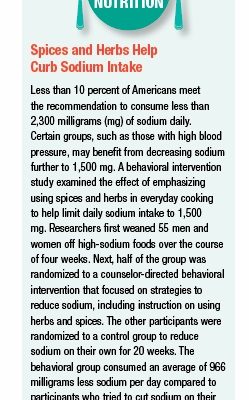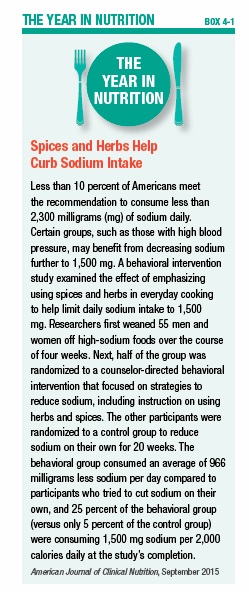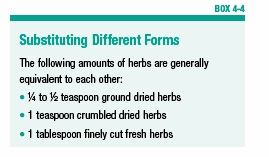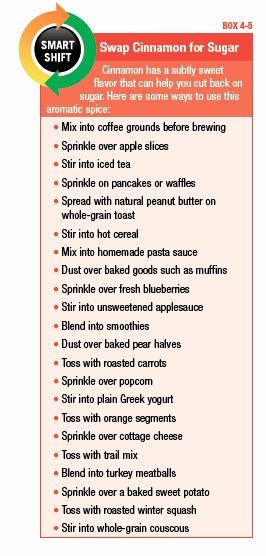4. Spices and Herbs
Flavor Your Plate
If you’d like to add a bit of pizazz to healthy, nutrient-dense whole foods such as vegetables and legumes, be creative and sprinkle on some spices and herbs. These seasonings generally cost only pennies per serving and can help you cut back on the fat, sugar, and salt you add to foods (see Box 4-1, “Spices and Herbs Help Curb Sodium Intake”). Besides providing a more healthful way to flavor foods, studies show that herbs and spices contain components that may help lessen inflammation, improve digestion, protect against harmful bacteria, support healthy blood sugar levels, and defend against cancer.
Antioxidant and Anti-Inflammatory Benefits
Collectively, herbs and spices contain more than 2,000 phytochemicals, many of which act as antioxidants. One study that evaluated the 50 foods highest in antioxidants revealed that the top five were spices (ground cloves, dried oregano, ground ginger, ground cinnamon, and turmeric powder). However, within the category of herbs and spices, the amount of antioxidants varies quite a bit, and we don’t typically consume a lot of these seasonings at one time. Thus, you should use herbs and spices to help you meet your antioxidant quota, rather than considering them as your sole antioxidant source. Certain components found in fruits and vegetables enhance the beneficial effects of herbs and spices.
Although herbs and spices have been used for medicinal purposes since the Middle Ages, scientific confirmation of their anti-inflammatory properties is fairly recent. Chronic inflammation is a contributor to many health conditions, including heart disease, cancer, obesity, and diabetes. Scientists believe that consuming anti-inflammatory herbs and spices on a daily basis could help reduce the risk of chronic diseases. Examples of common herbs and spices with anti-inflammatory activity include chili peppers, black pepper, bay leaves, ginger, marjoram, oregano, rosemary, sage, and thyme, but there are many others. For an explanation of the difference between herbs and spices, see Box 4-2, “Herb or Spice?” on page 35.
Using Herbs and Spices
Many studies looking at the health benefits of herbs and spices have been conducted in animals or test tubes, so the amounts of these seasonings required to produce a specific health effect in humans are often unclear. It’s possible that a single spice might produce only a small beneficial effect in the body, but when it’s consumed as part of a mixture of spices, there may be additive effects. Additionally, shifting to using herbs and spices in place of salt, butter, or highly processed condiments will improve the overall quality of your eating pattern.
Although it’s worth considering whether spices and herbs used in recipes could interact with medications you’re taking, little research has been published on this topic. At this point, experts believe that when spices and herbs are used in the small amounts typically found in recipes, they’re generally unlikely to cause a problem. For example, piperine, a phytochemical in black pepper, can increase the potency (bioavailability) of several drugs, but no interactions have been noted with the use of pepper as a spice on food.
Interactions of herbal supplements with medications are more likely, since supplements contain concentrated amounts of herbs. Similarly, the risk for drug interactions increases if you’re using larger amounts of herbs and spices regularly for health purposes, such as consuming a lot of garlic to help lower cholesterol or drinking ginger tea to calm nausea—both of these can interact with anticoagulant drugs, such as warfarin. For more information on herbal supplements, see page 24 in Chapter 2.
Stocking Your Spice Cabinet
Dried herbs and spices often have an expiration or “Best by” date to help ensure freshness. Check jars when you buy them, and, if not dated, mark them with your purchase date. If seasonings have little or no aroma when you rub them between your fingers and lack flavor, it’s time to replace them (see Box 4-3, “Freshness Guidelines for Seasonings”). If there’s little more than salt and pepper in your spice cabinet, it’s time to expand your inventory. To build your collection, the McCormick spice company suggests starting with the following everyday herbs and spices. (For help swapping dried herbs for fresh herbs in recipes, see Box 4-4, “Substituting Different Forms.”)
- Basil: This aromatic herb contains a wide range of potentially beneficial phytochemicals, including flavonoids and anthocyanins.
- In the kitchen: Pair it with tomatoes, eggplant, bell peppers, zucchini, white beans, and peas. It’s a natural fit with Italian cuisine.
- Chili powder: Besides ground, dried chiles, this spice blend also may contain allspice, cayenne pepper, cloves, coriander, cumin, garlic powder, onion powder, oregano, paprika, and/or salt.
- In the kitchen: Chili powder is well-known for its use in soups, stews, and bean dishes, but you can also try it on homemade trail mix, sprinkled over popcorn, and on sautéed vegetables.
- Cinnamon (ground): This popular spice may do much more than flavor your food. Emerging research suggests cinnamon may help support blood sugar control in people with type 2 diabetes. Using ¼ to ½ teaspoon of cinnamon daily (500 to 1,000 milligrams), the dosage commonly used in human clinical trials, is probably fine for most people with a healthy liver and kidneys, but be advised that cinnamon contains a natural blood-thinning agent and can interact with anticoagulant drugs such as warfarin. Consult your doctor before making cinnamon a daily part of your diet, and don’t use cinnamon in place of diabetes medication.
- Cumin: Its earthy, smoky flavor can really enhance the flavor of a dish, but a little goes a long way.
- In the kitchen: Add it to carrots, chickpeas, lentils, eggplant, potatoes, and peas. Use it in chili and Mexican-themed dishes. Make a black bean and tomato salad flavored with cumin, avocado, and lime juice.
- Garlic powder: A review of 39 clinical trials suggests that garlic may help reduce total cholesterol and LDL (bad) cholesterol in those with elevated blood cholesterol. However, daily doses used in studies ranged from 600 to 5,600 milligrams garlic powder (about ¼ teaspoon to 1¾ teaspoons). One fresh garlic clove is equivalent to one-fourth teaspoon of garlic powder.
- In the kitchen: Garlic powder adds a flavor boost to homemade pasta sauce and pairs well with vegetables, roast chicken, and beef stew.
- Ginger (ground): Studies suggest this pungent spice may help alleviate the symptoms of nausea and vomiting, such as after surgery, with cancer therapy, or in motion sickness. Some evidence also suggests it may help reduce inflammation and pain.
- In the kitchen: Add ¹⁄8 teaspoon to one cup of cooked carrots, sweet potatoes, or winter squash, or sprinkle into Asian stir‑fries.
- Oregano: This pungent herb contains several potent antioxidants, and preliminary evidence suggests it may help suppress inflammation. It’s best-known for the Italian flavor it imparts to dishes.
- In the kitchen: Use it to flavor beans, eggplant, homemade vinaigrette, roasted vegetables, summer squash, and soups.
- Red chili pepper: Chili peppers contain capsaicinoids, including capsaicin, which provide the spicy kick and also may help support appetite control.
- In the kitchen: Add a bit of ground red pepper or red pepper flakes to pastas, stews, soups, chili, stir-fries, and eggs.
- Rosemary: Rosemary contains oils that have anti-inflammatory properties and that may help stimulate memory.
- In the kitchen: Add it to legumes, garlic, olive oil, chicken, pork, potatoes, and tomatoes. Season grilled or baked salmon or other fish with lemon juice and rosemary.
The post 4. Spices and Herbs appeared first on University Health News.
Read Original Article: 4. Spices and Herbs »
Powered by WPeMatico







